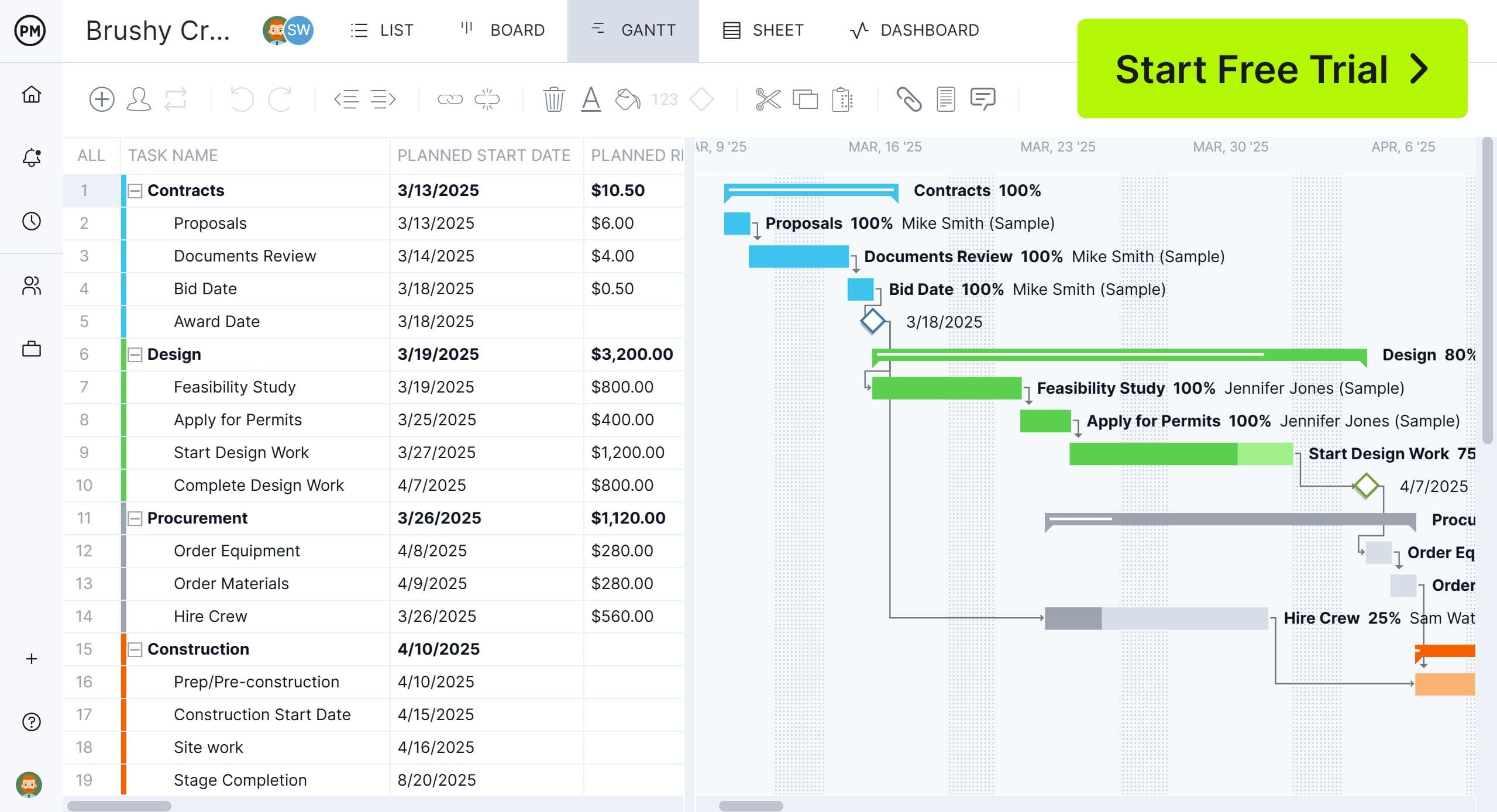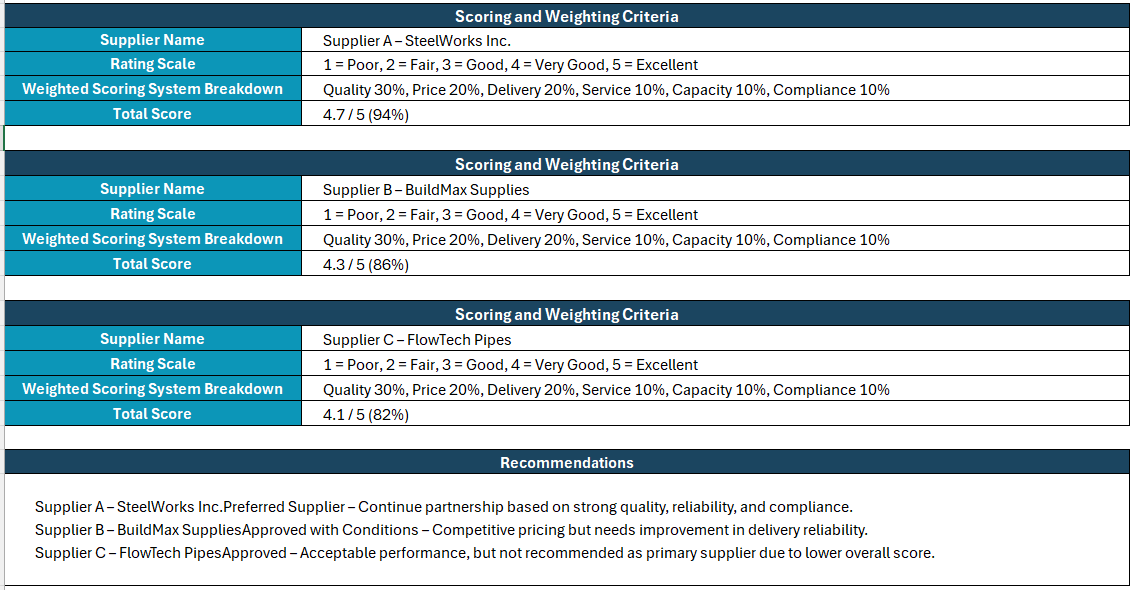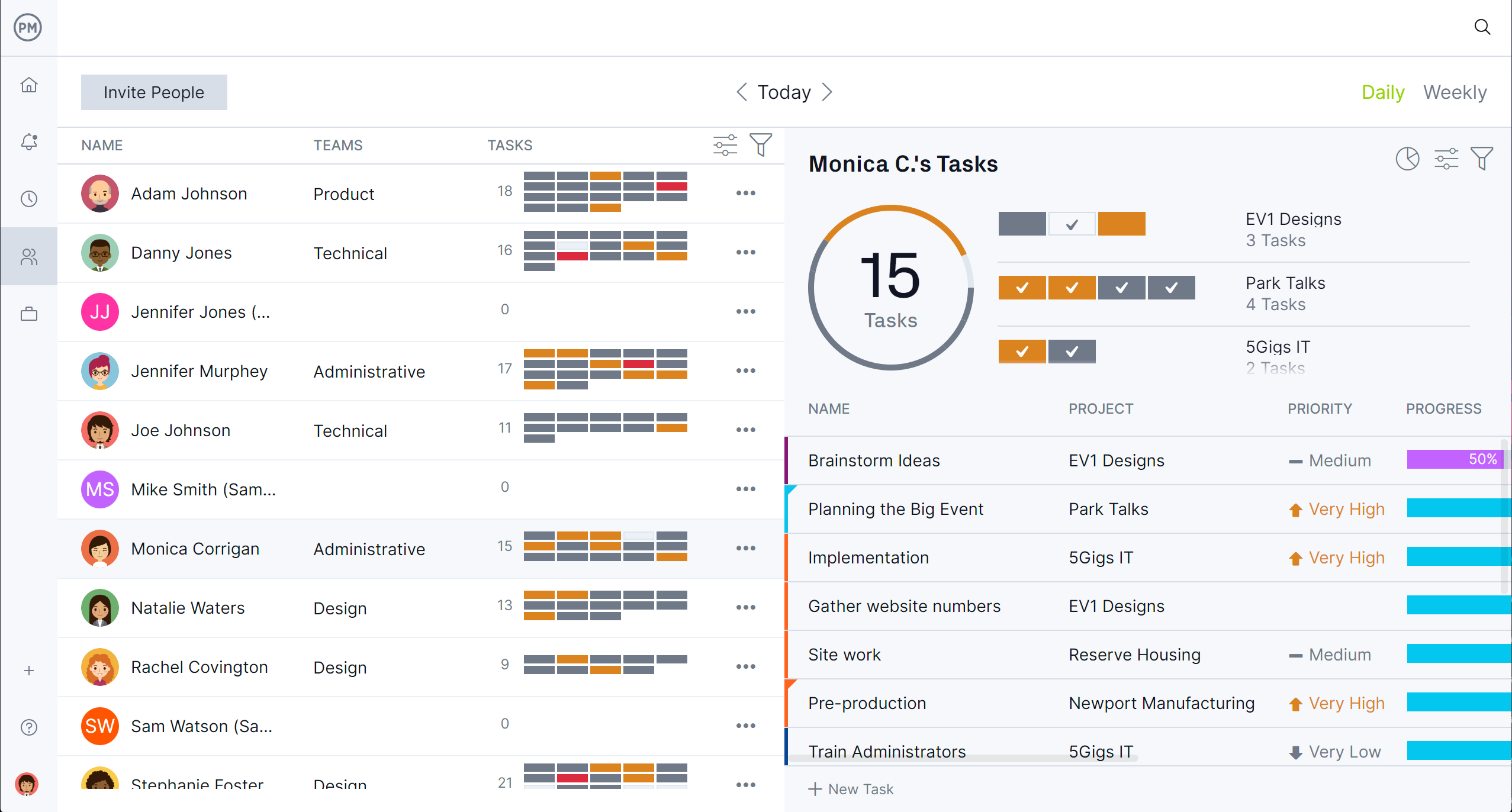A supplier evaluation form is a standardized document used to assess and compare potential or current suppliers based on key performance criteria such as quality, cost, reliability and compliance. It helps businesses make informed decisions about which suppliers to work with, ensuring that they meet organizational standards and project requirements. Collecting data in a consistent format simplifies supplier selection and ongoing performance monitoring.
Using a supplier evaluation form also creates a clear record of supplier performance over time. This information is critical for contract negotiations, quality control and risk management. Whether you are sourcing new vendors or reviewing existing partnerships, a well-structured form provides transparency and supports fair, data-driven decisions that improve procurement outcomes.
While a supplier evaluation form is useful, manually filling and updating it can become time-consuming—especially when managing multiple vendors across projects. Project management software streamlines this process by centralizing supplier data, automating updates and enabling collaboration between procurement teams. It eliminates the need for scattered spreadsheets and ensures everyone is working with the latest information.
ProjectManager takes supplier evaluation further by integrating supplier performance data directly into project plans. Its online Gantt chart lets you connect supplier-related tasks to project timelines, set dependencies and monitor progress in real time. When a supplier’s delivery date changes, you can quickly adjust schedules and instantly see the impact on the entire project plan. Combined with real-time dashboards and reporting, this ensures supplier performance is aligned with project goals and deadlines, keeping work on track and reducing costly delays.

Why You Need a Supplier Evaluation Form
A supplier evaluation form helps businesses systematically measure and compare suppliers based on objective criteria. This ensures that sourcing decisions are consistent, data-driven and focused on selecting vendors who meet quality, cost and delivery expectations. By tracking performance over time, organizations can strengthen supplier relationships, identify risks early and improve the overall reliability of their supply chain.

When to Use a Supplier Evaluation Form
Supplier evaluation forms can be used at several points throughout the procurement cycle, from onboarding new suppliers to performing periodic reviews of existing partners. They are especially helpful in industries where vendor performance directly impacts project timelines, quality and costs.
Construction Projects
In construction, a supplier evaluation form is useful for reviewing vendors of materials, equipment and subcontractor services. It helps ensure suppliers meet safety standards, delivery timelines and compliance requirements before being approved for critical projects.
Manufacturing Operations and Projects
Manufacturing relies on steady, high-quality inputs. Supplier evaluation forms help verify that vendors can deliver consistent volumes of raw materials or components on schedule, minimizing downtime and production delays.
Retail & Consumer Goods
For retail and consumer goods businesses, evaluating suppliers ensures that products meet brand quality standards, are delivered on time and comply with ethical sourcing or regulatory guidelines.
Who Should Use This Free Supplier Evaluation Form?
This form is designed for professionals across construction, manufacturing and operations who are responsible for selecting, monitoring and improving supplier performance.
Construction
- Project Manager: Uses the form to assess whether suppliers align with project timelines and deliverables.
- Procurement Manager: Evaluates vendors based on price competitiveness, delivery reliability and contract compliance.
- Site Engineer: Confirms that suppliers provide materials that meet technical specifications and site requirements.
- Quality Control Engineer: Uses the form to track defects, returns or compliance issues with materials received.
- Cost Controller: Monitors supplier pricing against budget forecasts to keep project costs under control.
Manufacturing
- Production Manager: Ensures suppliers meet production schedules and capacity needs.
- Supply Chain Manager: Reviews supplier reliability to maintain smooth inventory flow and reduce bottlenecks.
- Quality Assurance Manager: Tracks supplier performance against quality benchmarks and compliance standards.
- Operations Manager: Uses evaluation results to streamline processes, reduce waste and improve overall efficiency.
How to Use This Supplier Evaluation Form for Excel
This supplier evaluation form for Excel is designed to help teams collect consistent information about suppliers and evaluate their performance using a standardized scoring system. It’s structured to include company details, evaluation dates, products or services being reviewed and the key decision-makers involved. Using this template allows procurement and project teams to compare suppliers side by side, assess quality and compliance, and make informed sourcing decisions backed by data rather than assumptions.
Each section of the form guides users through gathering and systematically scoring supplier information. By organizing details like contact information, certifications and years in business along with performance criteria, the form helps stakeholders streamline the supplier review process and document recommendations in a professional, shareable format.
1. Enter Supplier Information
Begin by filling out the supplier’s name, ID or code, address, phone number, email and primary contact person. Add supporting details such as years in business and relevant certifications (ISO, OSHA compliance, etc.). This section ensures that everyone involved in the evaluation has full visibility into who the supplier is and what qualifications they bring.

2. Define an Evaluation Criteria and Scoring Scale
Customize the form’s criteria to reflect what matters most to your project or organization. Criteria often include product quality, delivery reliability, pricing, compliance with safety standards and customer service. Set a scoring scale (for example, 1–5 or 1–10) so evaluators can consistently rate each supplier against the same standards.

3. Log the Score for Each Supplier and Write Recommendations
Once scoring is complete, log the totals for each supplier to create a side-by-side comparison. Use the recommendations section to record whether to approve, reject or monitor the supplier’s performance going forward. This final step ensures that procurement decisions are documented clearly and can be reviewed by managers or auditors later if needed.

Free Related Manufacturing Templates
Managing manufacturing operations requires accurate tracking, documentation and planning tools that keep teams aligned. Using the right project management templates can streamline processes, reduce errors and improve communication across departments. Below are three free manufacturing templates that complement a supplier evaluation form and help optimize production planning, quality management and material tracking.
Inventory Template
Download this free inventory template to help teams keep accurate records of raw materials, components and finished goods. It allows users to log product names, SKUs, stock levels, reorder points and storage locations in one central sheet. This ensures that production schedules aren’t delayed by missing materials and that inventory is kept lean without risking stockouts.
SIPOC Template
Use this free SIPOC template (Suppliers, Inputs, Process, Outputs, Customers) to map high-level manufacturing processes from start to finish. This template allows teams to quickly identify suppliers, list inputs and outline process steps before defining deliverables and end customers. It’s a powerful tool for improving process clarity, spotting inefficiencies and aligning stakeholders on the production flow.
Bill of Materials Template
This free bill of materials template provides a structured list of every part, component and material needed to complete a product. It helps teams define quantities, part numbers and costs to ensure accurate planning and procurement. With a clear BOM, manufacturing teams can avoid production stoppages, track costs precisely and manage change orders more efficiently.
Free Related Construction Project Management Templates
Construction projects involve multiple moving parts, from planning and scheduling to budgeting and scope management. Using the right templates can help construction teams stay organized, meet deadlines and control costs. Below are three free construction project management templates that work well together to streamline project execution and keep stakeholders aligned.
Construction Schedule Template
Download this free construction schedule template to help project teams plan tasks along a clear timeline. It includes columns for task names, start and end dates and task owners, allowing managers to visualize dependencies and track progress. With this template, teams can stay on top of milestones, prevent delays and adjust schedules quickly as project conditions change.
Construction Budget Template
Use this free construction budget template to help track project costs from initial estimates to final expenses. It allows users to record labor, materials, equipment and subcontractor costs in a single spreadsheet. This makes it easier to stay within budget, compare planned versus actual spending and maintain financial control throughout the project.
Construction Scope of Work Template
This free template clearly defines project deliverables, work requirements and responsibilities for all stakeholders. By outlining tasks, deadlines and quality expectations, it ensures that everyone is aligned on what needs to be completed. A clear scope of work helps reduce misunderstandings, manage change orders and keep projects on track.
How ProjectManager Helps With Construction and Manufacturing Projects
Managing construction and manufacturing projects requires visibility across multiple workflows, teams and deadlines. ProjectManager makes this easier by offering multiple project views beyond just Gantt charts. Teams can switch between list, kanban board, sheet and calendar views to see tasks in the format that works best for them. This flexibility ensures that everyone stays aligned, from field crews and engineers to procurement and operations staff, while keeping work organized in real time.
Streamline Workflows With Resource Management Tools
Resource management is one of the biggest challenges in construction and manufacturing projects, where labor, materials and equipment must be carefully coordinated. ProjectManager’s resource management tools give managers a clear picture of team availability and workload. The workload chart highlights which team members are overallocated or underutilized, allowing managers to reassign tasks before issues arise. Material and cost tracking features ensure resources are used efficiently, reducing waste and preventing project delays caused by shortages or bottlenecks.

Track Progress and Stay Ahead of Issues
Tracking performance across job sites, production lines and teams is critical to delivering projects on time and within budget. ProjectManager provides real-time dashboards that display live updates on task completion, costs and resource usage. Customizable reports let managers drill down into specific areas, such as labor hours or procurement spend, for better decision-making. Automated alerts and task dependencies keep projects moving forward by notifying teams of upcoming deadlines and potential risks. These tracking tools help catch problems early and keep projects on schedule.

Related Manufacturing and Construction Content
A supplier evaluation form is used in manufacturing and construction. For those who want to read further on these topics, there are a number of links below that lead to stories on material requirements planning, material takeoff and more.
- Material Requirements Planning (MRP): A Quick Guide
- How to Make a Material Schedule for Construction
- Material Takeoff (MTO) in Construction: A Quick How-to Guide
- What Is a Bill of Materials? (Example & Template Included)
ProjectManager is online project and portfolio management software that connects teams, whether they’re in the office or out in the field. They can share files, comment at the task level and stay updated with email and in-app notifications. Get started with ProjectManager today for free.
